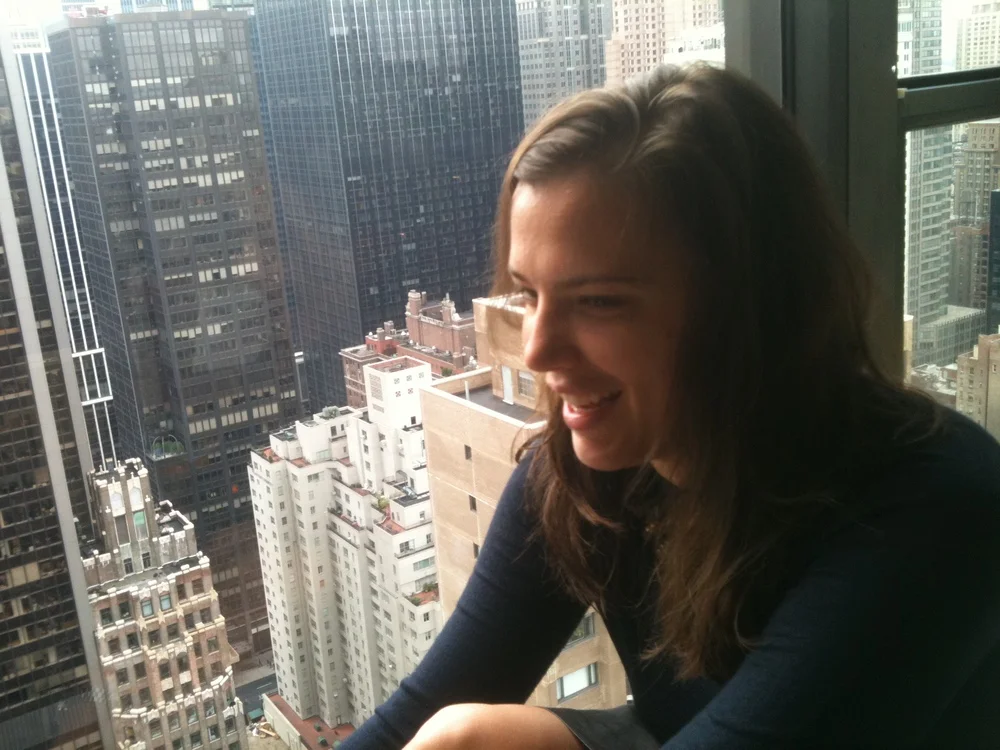FEATURED ARTIST | AUGUST 2013
Bio: Erika Huddleston is a Texas painter who studies urban parks and their relationship to the city dweller. She works entirely outdoors, sitting on the ground with her canvas for full days from 9:00 am to dusk. First, she walks the site for several days or weeks without any preparatory sketches. Then she chooses her subject and begins painting in oil after making an underdrawing in pencil. Erika has a BA in Fine Arts and went to Parsons School of Design for Interior Decoration, and has a Masters in Landscape Architecture. She works in Dallas and Austin, and currently is doing a series on the Trinity River near Corinth Street Bridge in Dallas.
Hometown: Dallas, Texas
Favorite Dallas hangout: the Santa Fe Trail in Lakewood
Website: www.erikahuddleston.com
AHD: You've modestly referred to yourself as a landscape architect who paints, but your work teems with the thought and precision of an experienced artist. How long have you painted nature in urban settings?
EH: The series of "Landscape Recordings" began three years ago and continues now with my new work on the Trinity River in Dallas. I was in graduate school for landscape architecture and was tired of mapping aerially many of our sites that we were designing. I asked to do a research project on painting onsite rather than using maps as a way to gather information.
Shoal Creek Greenbelt in Austin (I was at UT) was my first chosen site to document. After spending 500 hours sitting outdoors, my ideas about the site totally changed. I don't think everything can be understood from a nuts and bolts "model" driven approach to a landscape-or even as an approach to a person. I continue to refine and challenge my own ideas on this subject through this work at my second location at the Trinity River in Dallas. I hope to write a series of articles on the resulting research after this work.
AHD: Where did you acquire your appreciation for inner city green spaces?
EH: Living in New York City! I lived in Dallas and then Nashville so moving to New York was a huge transition as far as not being in a quasi-suburban setting. It was like moving to "Sesame Street" which was set in the Bronx! I read Jane Jacobs' "The Death and Life of Great American Cities" which discusses urban planning strategies such as the life of the sidewalk and the importance of living in a walkable community such as Jacobs' own neighborhood, Greenwich Village. I loved community gardens as I walked by them and I volunteered very early on for the High Line-for three years.
I felt the calling to devote my life to understanding and advocating for thoughtful connections to nature in cities. I would pass community gardens and stand against the metal bar fencing and look in and be nourished for two minutes seeing green-then move on down the sidewalk. Eventually, I lived in New York City for 6 years and the importance of the green in Central Park and other tiny "pocket parks" made me want to design landscape. I've always worked in design and was at the time working in textile and interior design, designing interiors, yet I decided to move to city design and landscape design. I have an art background and merged the two with the paintings of landscapes.
AHD: How has the study of fine and decorative arts, as well as landscape architecture given you a unique perspective not only on painting and urban planning, but life itself?
EH: Life is long and hard. Until after college, when the predestined parts of "life" end, there is a forward momentum, but then after graduation one's "work" becomes a 9-5 job instead of school hours. I find that adult life is enhanced by surprises and variety. I find a real surprise and variety, and therefore solace in ungroomed nature. However, in the city, residents can leave on the weekends, but wouldn't it be wonderful to go to a city park and be able to walk and explore within a wilderness area that wasn't lawn and organized trees. Cities are built in the wilderness and the remnant of that landscape is important to recollect and be able to engage within.
Art is about exploration and unknown potentials. I am okay with the open ended, unpredictability of art-through schooling in college-so I think that comfort with exploration and precipices and curiosity without worry informs my perspective on what I seek to find in an urban park. A background in art is more playful in a way than a background in architecture or landscape architecture, which has all the legal liabilities at stake like someone tripping on a path or a structure collapsing. Art as my background allowed a "lightness" and freedom to pervade my later work in landscape architecture.
After all, good design emerges from ideas about life. We can't let the harshness of a broken world eliminate all lavish joy from our city parks. I see more and more that our world was meant for that magnificent rejoicing and I think that we regain that in moments through art and design which are called to reflect that.
AHD: This month you're participating in Summer Colors, an art show and silent auction benefiting Texas Scottish Rite Hospital for Children. Why is the cause important to you, and why do you think artists should lend their time and talents for the common good?
EH: A friend has worked for Scottish Rite for almost 10 years and I respect her work and her mission. The Hospital has served Dallas unceasingly for so many years so the cause is important to me. I drive by Scottish Rite on Oak Lawn often and appreciate that the people there serve our city. Artists like any other profession are called to contribute directly to the common pot of giving.
AHD: Your process and products are statements about the passage of time. Why it is important for us to slow down and reconnect with nature, and how can the creative community help make certain we do?
EH: The passage of time is almost an oxymoron in perception now that smartphones have allowed real time communication. Although time passes as it always has, I don't feel the passing of time. I don't have to wait as much as I used to in moments. Yet, in larger life issues, I often must wait or have patience to understand or feel or process what is happening. If we can walk into a park that we go to often and witness the changing of seasons, the changing of a leaf's color, the moving of a creek's water, the rustling of a forest of trees planted 50 years ago, then we can connect to the larger timescale of life beyond realtime.
The creative community produces work that moves us beyond realtime. Madeleine L'Engle wrote in "Walking on Water" that there are two types of time: "Kairos" time and "chronos" time. Kairos time occurs when a good dinner party with friends feels like it lasts for hours but was only one hour. Chronos time is the tic-toc of chronological time with all of our standards and procedures ticking onward. We need both, but I feel that the world is more data-driven than ever and that the calling of urban parks today is to provide a place to experience kairos time. Music, literature, and all creative expressions can create a place to experience kairos time as well. Kairos time points to God's spirit that is beyond time.
AHD: An Austin arts and culture magazine reported you spent over 500 hours in one park working on a recent series. Do you feel like that kind of dedication and focus is perhaps lacking in the contemporary art scene?
EH: Well, the contemporary art scene often explores perceptual concepts of time and space so quantifying the time is not unusual. That amount of time is my own process and the only reason to examine an artist's process is because we are used to doing that as we examine our own lives, our friends' lives on Facebook, and we value our emotions as a society in America. I would even say we overly elevate the importance of our own perceptions. The contemporary art scene examines many of these ideas in concept. I don't think in practice that dedication and focus is lacking in contemporary art; artists work to make their art and that work is breathless no matter how long or short.
AHD: For creatives out there who haven't yet discovered a subject that evokes such passion, how do you suggest they find a setting that moves them?
EH: I suggest that one starts reading widely. For me, I am inspired by reading the newspapers. Once an idea then occurs to me after reading lots of newspapers discussing current events, I then produce my work. I would recommend to then try many different media, one at a time, until one seems to hit something special. There is something about the physical process that helps me understand what I was thinking theoretically.
AHD: How can we learn more about you and your work, and check out a painting or print in person?
EH: My show at Shannon Bowers art space on Dragon St. is up in September with the opening on September 12. There will be the new series of work on the Trinity River hanging. There is a street fair with DADA on Dragon St. shortly thereafter and the work will be up then, too! Check out my work on my website as well: http://erikahuddleston.com/




